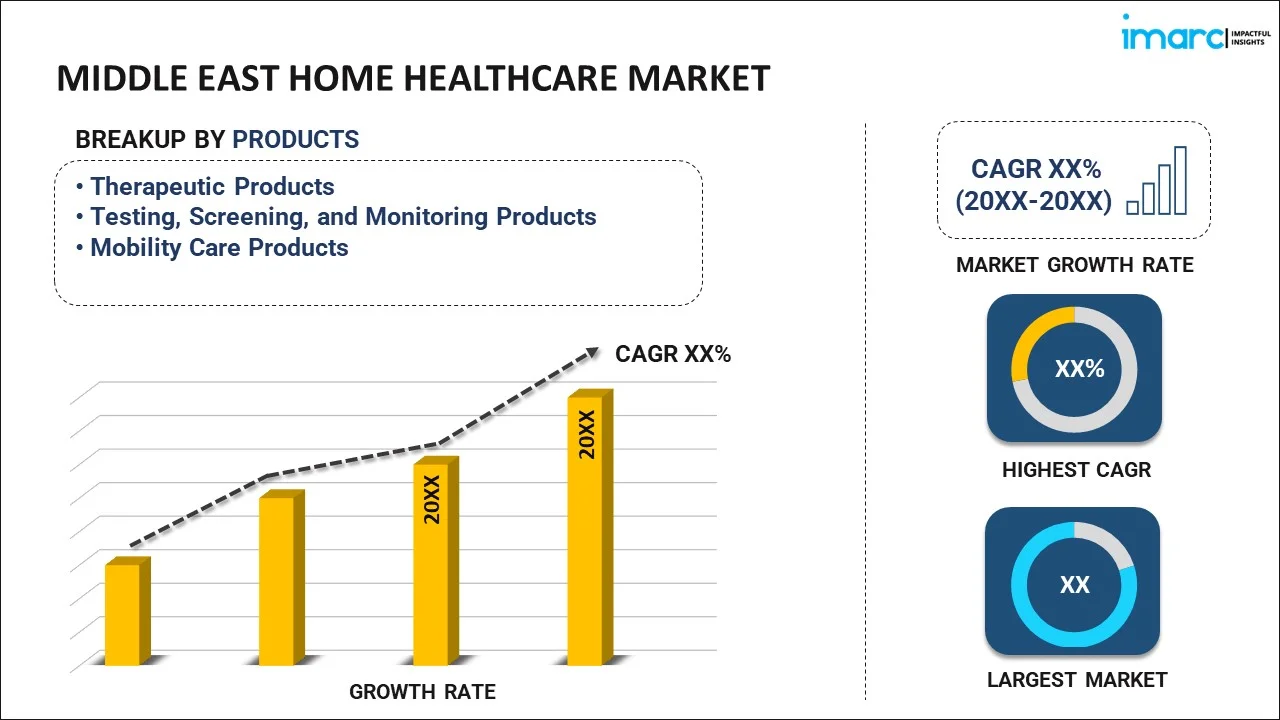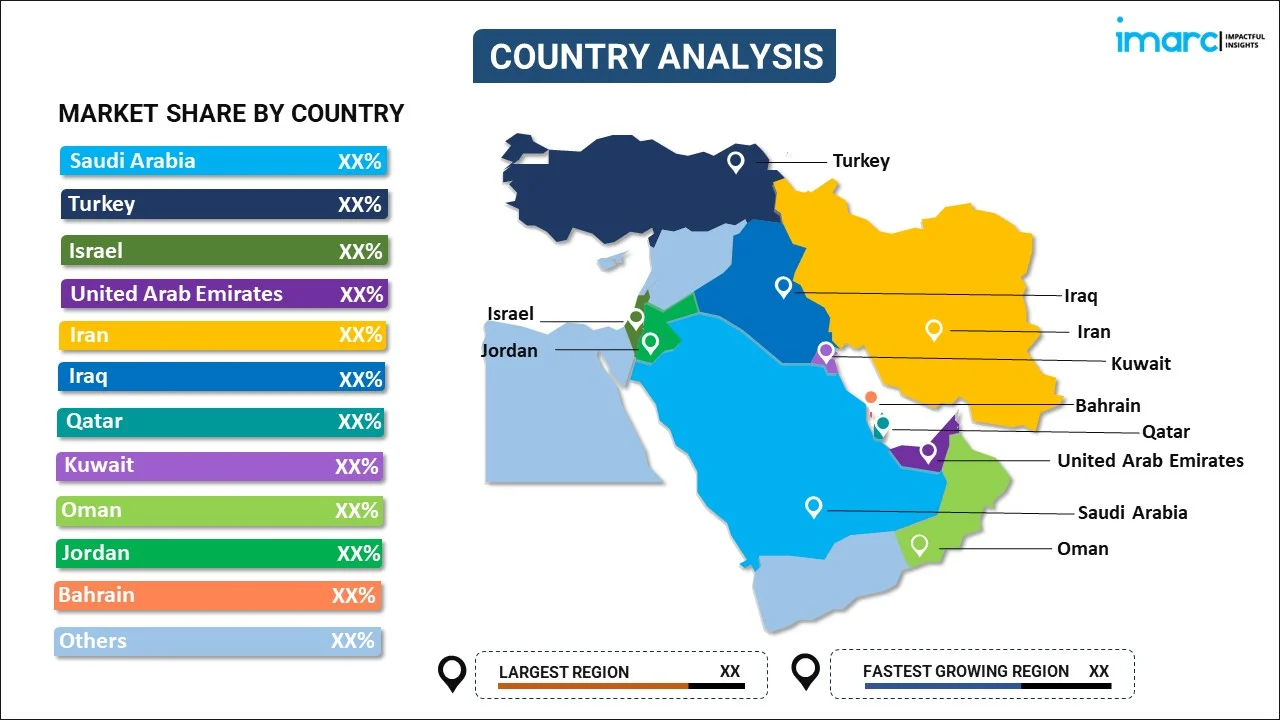
Middle East Home Healthcare Market Report by Product (Therapeutic Products, Testing, Screening, and Monitoring Products, Mobility Care Products), Service (Skilled Nursing, Rehabilitation Therapy, Hospice and Palliative Care, Unskilled Care, Respiratory Therapy, Infusion Therapy, Pregnancy Care), Indication (Cancer, Respiratory Diseases, Movement Disorders, Cardiovascular Diseases and Hypertension, Pregnancy, Wound Care, Diabetes, Hearing Disorders, and Others), and Country 2025-2033
Market Overview:
The Middle East home healthcare market size is projected to exhibit a growth rate (CAGR) of 6.37% during 2025-2033. The region's aging population, ongoing technological advancements in telehealth, and supportive government policies fostering a shift toward cost-effective, personalized healthcare services within the comfort of the home represent some of the key factors driving the market.
|
Report Attribute
|
Key Statistics
|
|---|---|
|
Base Year
|
2024 |
|
Forecast Years
|
2025-2033
|
|
Historical Years
|
2019-2024
|
| Market Growth Rate (2025-2033) | 6.37% |
Home healthcare is a specialized service tailored to meet individual health needs within the comfort of one’s home. This form of healthcare is administered by skilled professionals, including nurses, therapists, and home health aides. They deliver a range of services, from medical treatments and monitoring to assistance with daily activities and rehabilitation exercises. The flexibility and personalized nature of home healthcare make it a preferred option for many. It allows patients to receive quality medical care while remaining in a familiar and comfortable environment, often leading to faster recovery and better mental health outcomes. It can also be a cost-effective alternative to hospital or long-term care facility stays. Advancements in technology and telehealth are further enhancing the capabilities of home healthcare, enabling remote monitoring and consultations. This integration of technology ensures continuous and comprehensive care, making it a viable option for a wide range of medical needs. Home healthcare supports the physical well-being of patients and offers emotional and psychological benefits by allowing them to maintain a sense of independence and connection with their community. In recent years, home healthcare has gained immense traction across the Middle East region, catering to those requiring medical attention due to chronic illness, disability, or recovery from surgery.
Middle East Home Healthcare Market Trends:
The Middle East home healthcare market is experiencing robust growth, driven by a confluence of factors that reflect both regional specificities and global healthcare trends. One of the primary drivers includes an expanding geriatric population in the region, who often have chronic health conditions requiring long-term care. This aging demographic is more inclined toward home healthcare owing to its convenience and the comfort of staying in familiar surroundings. Moreover, technological advancements, such as the integration of telehealth and remote monitoring technologies that facilitate efficient and effective patient care, are revolutionizing and expanding the reach of home healthcare services. This technological enablement is particularly crucial in areas with limited access to traditional healthcare facilities. Additionally, several Middle Eastern countries are actively promoting healthcare sector reforms and investments, focusing on improving healthcare quality and accessibility. In line with this, the rising government initiatives and support for home healthcare services as a means to alleviate pressure on traditional healthcare facilities and provide cost-effective care are fueling the market growth. Furthermore, there is a heightened awareness and acceptance of home healthcare services in the region, with more individuals opting for home healthcare solutions due to inflating healthcare costs and the increasing desire for personalized care. This shift is further supported by various cultural factors, as home care aligns with the region’s family-centric values. Along with this, the recent coronavirus (COVID-19) pandemic outbreak has accelerated the adoption of home healthcare services as individuals seek to minimize hospital visits and exposure risks. The pandemic underscored the importance of accessible healthcare services, thus catalyzing the demand for home healthcare and propelling market growth.
Middle East Home Healthcare Market Segmentation:
IMARC Group provides an analysis of the key trends in each segment of the market, along with forecasts at the regional and country levels for 2025-2033. Our report has categorized the market based on product, service, and indication.
Product Insights:

- Therapeutic Products
- Testing, Screening, and Monitoring Products
- Mobility Care Products
The report has provided a detailed breakup and analysis of the market based on the product. This includes therapeutic products, testing, screening, and monitoring products, and mobility care products.
Service Insights:
- Skilled Nursing
- Rehabilitation Therapy
- Hospice and Palliative Care
- Unskilled Care
- Respiratory Therapy
- Infusion Therapy
- Pregnancy Care
A detailed breakup and analysis of the market based on the service have also been provided in the report. This includes skilled nursing, rehabilitation therapy, hospice and palliative care, unskilled care, respiratory therapy, infusion therapy, and pregnancy care.
Indication Insights:
- Cancer
- Respiratory Diseases
- Movement Disorders
- Cardiovascular Diseases and Hypertension
- Pregnancy
- Wound Care
- Diabetes
- Hearing Disorders
- Others
The report has provided a detailed breakup and analysis of the market based on the indication. This includes cancer, respiratory diseases, movement disorders, cardiovascular diseases and hypertension, pregnancy, wound care, diabetes, hearing disorders, and others.
Country Insights:

- Saudi Arabia
- Turkey
- Israel
- United Arab Emirates
- Iran
- Iraq
- Qatar
- Kuwait
- Oman
- Jordan
- Bahrain
- Others
The report has also provided a comprehensive analysis of all the major regional markets, which include Saudi Arabia, Turkey, Israel, United Arab Emirates, Iran, Iraq, Qatar, Kuwait, Oman, Jordan, Bahrain, and Others.
Competitive Landscape:
The market research report has also provided a comprehensive analysis of the competitive landscape in the market. Competitive analysis such as market structure, key player positioning, top winning strategies, competitive dashboard, and company evaluation quadrant has been covered in the report. Also, detailed profiles of all major companies have been provided.
Middle East Home Healthcare Market Report Coverage:
| Report Features | Details |
|---|---|
| Base Year of the Analysis | 2024 |
| Historical Period | 2019-2024 |
| Forecast Period | 2025-2033 |
| Units | Million USD |
| Scope of the Report | Exploration of Historical and Forecast Trends, Industry Catalysts and Challenges, Segment-Wise Historical and Predictive Market Assessment:
|
| Products Covered | Therapeutic Products, Testing, Screening, and Monitoring Products, Mobility Care Products |
| Services Covered | Skilled Nursing, Rehabilitation Therapy, Hospice and Palliative Care, Unskilled Care, Respiratory Therapy, Infusion Therapy, Pregnancy Care |
| Indications Covered | Cancer, Respiratory Diseases, Movement Disorders, Cardiovascular Diseases and Hypertension, Pregnancy, Wound Care, Diabetes, Hearing Disorders, Others |
| Countries Covered | Saudi Arabia, Turkey, Israel, United Arab Emirates, Iran, Iraq, Qatar, Kuwait, Oman, Jordan, Bahrain, Others |
| Customization Scope | 10% Free Customization |
| Post-Sale Analyst Support | 10-12 Weeks |
| Delivery Format | PDF and Excel through Email (We can also provide the editable version of the report in PPT/Word format on special request) |
Key Questions Answered in This Report:
- How has the Middle East home healthcare market performed so far and how will it perform in the coming years?
- What has been the impact of COVID-19 on the Middle East home healthcare market?
- What is the breakup of the Middle East home healthcare market on the basis of product?
- What is the breakup of the Middle East home healthcare market on the basis of service?
- What is the breakup of the Middle East home healthcare market on the basis of indication?
- What are the various stages in the value chain of the Middle East home healthcare market?
- What are the key driving factors and challenges in the Middle East home healthcare?
- What is the structure of the Middle East home healthcare market and who are the key players?
- What is the degree of competition in the Middle East home healthcare market?
Key Benefits for Stakeholders:
- IMARC’s industry report offers a comprehensive quantitative analysis of various market segments, historical and current market trends, market forecasts, and dynamics of the Middle East home healthcare market from 2019-2033.
- The research report provides the latest information on the market drivers, challenges, and opportunities in the Middle East home healthcare market.
- Porter's five forces analysis assist stakeholders in assessing the impact of new entrants, competitive rivalry, supplier power, buyer power, and the threat of substitution. It helps stakeholders to analyze the level of competition within the Middle East home healthcare industry and its attractiveness.
- Competitive landscape allows stakeholders to understand their competitive environment and provides an insight into the current positions of key players in the market.
Need more help?
- Speak to our experienced analysts for insights on the current market scenarios.
- Include additional segments and countries to customize the report as per your requirement.
- Gain an unparalleled competitive advantage in your domain by understanding how to utilize the report and positively impacting your operations and revenue.
- For further assistance, please connect with our analysts.
 Inquire Before Buying
Inquire Before Buying
 Speak to an Analyst
Speak to an Analyst
 Request Brochure
Request Brochure
 Request Customization
Request Customization




.webp)




.webp)












